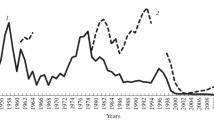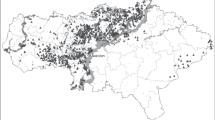Abstract
Since the beginning of the 20th century, the number of saigas (Saiga tatarica tatarica L., 1766) sharply decreased twice as a result of human activity. After the first decrease, all four saiga populations (the Northwest Pre-Caspian, Ustyurt, Volga–Ural, and Betpakdala) recovered, and they numbered more than 1 million heads by the 1970–80s. However, after the second decrease (since the beginning of the 21st century), an increase in the number of these ungulates has been noted only for two populations, the Volga–Ural and Betpakdala. The goal of the study is to analyze the biological parameters of the four populations and to identify the differences that allowed the saigas inhabiting the Volga–Ural interfluve and Betpakdala to overcome population depression and to recover their numbers. At the end of the 20th century, the economic situation in the countries inhabited by saigas promoted poaching among the population, which led to a sharp decrease in the total number of these ungulates down to 50 000. The area of the main range decreased by 50 times for the Northwest Pre-Caspian saiga population and by 2.4–5 times for the other three populations. The distance of seasonal migrations, as well as animal involvement, also decreased. The saiga population of the Northwest Pre-Caspian has become practically sedentary. The low-number periods are characterized by a decrease in herds of different sizes found throughout the year; herds with less than 50 animals were registered in 56–100% of cases. In the early 2000s, the main biological parameters characterizing the four saiga populations were comparable. Moreover, the proportion of adult males and the yield of young animals per female in July–August were higher in the population of the Northwest Pre-Caspian in comparison to the other three (11.5 ± 1.9% and 0.81 ± 0.18 ind. vs. 8.7 ± 3.8% and 0.48 ± 0.40 ind., respectively). The increase in the Volga–Ural and Betpakdala populations is mainly due to their effective protection and the education of the local people with the support of the Kazakhstan government and international foundations, which significantly reduce the poaching pressure.


Similar content being viewed by others

Notes
The total fecundity of females is estimated according to the number of calves born to each female from the entire population (author’s note).
REFERENCES
All about the saiga, 2020. https://wwf.ru/species/saygak-prikaspiyskiy/saiga/. Accessed October 15, 2020.
Appaev, B., What happens if the last saiga remains, Kalmyk Pravda, 2016. http://halmgynn.ru/4494-esli-ostanetsya-posledniy-saygak-v-etom-budem-vinovaty-my-vse.html. Accessed October 15, 2020.
Baidavletov, E.R., Grachev, A.A., Kantarbaev, S.S., Saparbaev, S.K., Baidavletov, R.Zh., Bekmanov, N.M., and Grachev, Yu.A., Counting and monitoring of saiga in Kazakhstan in 2017, Saiga News, 2018, no. 23, pp. 19–23.
Bannikov, A.G., Zhirnov, L.V., Lebedeva, L.S., and Fandeev, A.A., Biologiya saigaka (Biology of Saiga), Moscow: Sel’khozgiz, 1961.
Bliznyuk, A.I., Saigak kalmytskoi populyatsii (Saiga of Kalmyk Population), Elista: Dzhangar, 2009.
Bogun, S.A., The state of the saiga population in the Chernye Zemli Nature Reserve: problems and its possible conservation, Materialy VI Mezhdunarodnoi mauchno-prakticheskoi konferentsii “Osobo okhranyaemye prirodnye territorii: proshloe, nastoyashchee, budushchee,” Khvalynsk, 17–18 oktyabrya 2019 g. (Proc. VI Int. Sci.-Pract. Conf. “Strictly Protected Natural Areas: Past, Present, and Future,” Khvalynsk, October 17–18, 2019), Saratov: Amirit, 2019, pp. 7–14.
Economy of Kazakh SSR, 2020. https://ru.wikipedia.org/ wiki/Экономика_Казахской_ССР. Accessed November 3, 2020.
Fadeev, V.A. and Sludskii, A.A., Saigak v Kazakhstane (Ekologiya, khozyaistvennoe znachenie) (Saiga in Kazakhstan: Ecology and Economic Role), Alma-Ata: Nauka, 1982.
Filippova, A., Otchet po issledovaniyu nelegal’nogo rynka derivatov saigaka na territorii RF (Report on the Analysis of the Illegal Market for Saiga Derivatives in Russian Federation), Moscow: Mezhdunar. Fond Zashch. Zhivotn., IFAW. 2018.
Frank, D.A., McNaughton, S.J., and Tracy, B.F., The ecology of the Earth’s grazing ecosystems: profound functional similarities exist between the Serengeti and Yellowstone, BioScience, 1998, vol. 48, no. 7, pp. 513–521.
Gabunshchina, E.B., Specific development of agriculture in the Republic of Kalmykia in transition period, Vestn. Kalmyts. Inst. Gumanit. Issled., Ross. Akad. Nauk, 2010, no. 2, pp. 90–95.
Grachev, Yu.A. and Bekenov, A.B., State of saiga populations and prospects for saiga conservation in Kazakhstan, Stepnoi Byull., 2006, nos. 21–22, pp. 15–17.
Grachev, Yu.A., Meldebekov, A.M., and Bekenov, A.B., Abundance, structure, and reproduction of saiga population in Kazakhstan, Stepnoi Byull., 2009, no. 27, pp. 47–50.
Harris, G., Thirgood, S., Hopcraft, J.G.C., Cromsigt, J.P.G.M., and Berger, J., Global decline in aggregated migrations of large terrestrial mammals, Endangered Species Res., 2009, vol. 7, pp. 55–76.
Kalmykia in digits, 2020. https://astrastat.gks.ru/storage/ mediabank/Калмыкия в цифрах_2020.pdf. Accessed November 3, 2020.
Karimova, T.Yu. and Lushchekina, A.A., Specific spatial distribution and ethological structure of the saiga population on the territory of the Stepnoi Nature Reserve (Astrakhan oblast), Ekosist.: Ekol. Din., 2018, vol. 2, no. 1, pp. 73–91. http://www.ecosystemsdynamic.ru. Accessed October 15, 2020.
Karimova, T.Yu., Lushchekina, A.A., Neronov, V.M., Pyurvenova, N.Yu., and Arylov, Yu.N., Biological features of the Northwest Pre-Caspian saiga population at different sizes, Arid Ecosyst., 2020, vol. 10, no. 4, pp. 298–304.
Kholodova, M.V., Milner-Gulland, E.J., Easton, A.J., Amgalan, L., Arylov, Iu.A., Bekenov, A., Grachev, Iu.A., Lushchekina, A.A., and Ryder, O., Mitochondrial DNA variation and population structure of the critically endangered saiga antelope Saiga tatarica, Oryx, 2006, vol. 40, no. 1, pp. 1–2.
Kirikov, S.V., Promyslovye zhivotnye, prirodnaya sreda, chelovek (Coomerical Animal Species, Environment, and a Man), Moscow: Nauka, 1966.
Livestock population has increased in Kazakhstan, 2020. https://forbes.kz/news/2020/06/12/newsid_227295. Accessed October 15, 2020.
Migushin, A.A. and Gorskikh, V.G., State of the saiga population in Kazakhstan, Trudy nauchno-prakticheskoi konferentsii nauchnogo obshchestva studentov i aspirantov biologo-tekhnologicheskogo fakul’teta Novosibirskogo GAU “Problemy biologii, zootekhniki i biotekhnologii,” 18 dekabrya 2017 g. (Proc. Sci.-Pract. Conf. of Scientific Society of Students and Post-Graduate Students of the Faculty of Biology and Technology, Novosibirsk State Agrarian University “Problems of Biology, Animal Science, and Biotechnology,” December 18, 2017), Novosibirsk, 2018, pp. 42–45.
Morrison, J.C., Sechrest, W., Dinerstein, E., Wilcove, D.S., and Lamoreux, J.F., Persistence of large mammal fauna as indicators of global human impact, J. Mamm., 2007, vol. 88, no. 6, pp. 1363–1380.
Nurushev, M.Zh. and Baitanaev, O.A., Problems and methods of saiga conservation (Saiga tatarica L.) in Kazakhstan, Byull. Orenb. Nauchn. Tsentra, Ural. Otd., Ross. Akad. Nauk, 2018, no. 1, pp. 1–19. http://elmag.uran.ru: 9673/magazine/Numbers/2018-1/Articles/ZNM-2018-1.pdf. Accessed October 15, 2020.
Overview report, 2015. https://www.cms.int/sites/default/ files/document/Saiga.MOS3_Overview_Report_of_ Conservation_Status_Rus.pdf. Accessed November 3, 2020.
Portnyagina, N., Saiga came … to eat, 2020. https://www.kazpravda.kz/articles/view/prishla-saiga-stolovatsya. Accessed November 3, 2020.
Report of activities of the Association for the Conservation of Biodiversity of Kazakhstan in 2011–2015, 2015. https://www.cms.int/sites/default/files/document/ Отчет АСБК 2011-2015_R.pdf. Accessed November 3, 2020.
Saigak: filogeniya, sistematika, ekologiya, okhrana i ispol’zovanie (Saiga: Phylogeny, Systematics, Ecology, Protection, and Use), Sokolov, V.E. and Zhirnov, L.V., Eds., Moscow: Rossel’khozakademiya, 1998.
Salikhov, T.K., The current state of the Ural saiga population on the territory of the Bokeiorda State Nature Reserve in West Kazakhstan oblast, Gidrometeorol. Ekol., 2016, no. 4, pp. 147–156.
Tazhibaeva, Zh.O., Improving the efficiency of land management of the Republic of Kazakhstan, Sofiya, 2019, no. 2, pp. 57–63.
The IUCN Red List of Threatened Species. 2007. https://www.iucn.org/sites/dev/files/import/downloads/ species_extinction_05_2007.pdf. Accessed November 3, 2020.
Ukrainskii, V.V. and Ukrainskii, E.V., The results of monitoring of the Betpak-Dala saiga population before mass mortality in 2015, Materialy III Mezhdunarodnoi nauchnoi konferentsii “Biologicheskoe raznoobrazie aziatskikh stepei,” Kostanai, Kazakhstan, 24–27 aprelya 2017 g. (Proc. III Int. Sci. Conf. “Biological Diversity of Asian Steppes,” Kostanai, Kazakhstan, April 24–27, 2017), Kostanai, 2017, pp. 127–132.
Ukrainskii, V.V., Ukrainskii, E.V., and Pereladova, O.B., Saiga monitoring to support species conservation: an example of the Betpak-Dala population, Stepnoi Byull., 2019, nos. 51–52, pp. 58–63.
Zhirnov, L.V., Vozvrashchennye k zhizni (ekologiya, okhrana i ispol’zovanie saigakov) (Returned to Life: Ecology, Protection, and Use of Saiga), Moscow: Lesnaya Promyshlennost’, 1982.
ACKNOWLEDGMENTS
The authors are grateful to the staff of the Stepnoy Nature Reserve and its director, V.G. Kalmykov, for great assistance in the collection of material for this study.
Funding
The work was carried out on the research topic of the Severtsov Institute of Ecology and Evolution, Russian Academy of Sciences, State assignment no. 0109-2019-0009, “Fundamental problems of wildlife conservation and the rational use of biological resources.”
Author information
Authors and Affiliations
Corresponding author
Ethics declarations
Conflict of interests. The authors declare that they have no conflicts of interest.
Statement on the welfare of animals. All applicable international, national, and/or institutional guidelines for the care and use of animals were followed.
Additional information
Translated by T. Kuznetsova
Rights and permissions
About this article
Cite this article
Karimova, T.Y., Lushchekina, A.A. & Neronov, V.M. Saiga Populations of Russia and Kazakhstan: Current Status and Retrospective Analysis of Some Biological Parameters. Arid Ecosyst 11, 164–172 (2021). https://doi.org/10.1134/S2079096121020074
Received:
Revised:
Accepted:
Published:
Issue Date:
DOI: https://doi.org/10.1134/S2079096121020074



